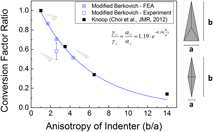Article contents
Determination of directionality of nonequibiaxial residual stress by nanoindentation testing using a modified Berkovich indenter
Published online by Cambridge University Press: 20 September 2018
Abstract

We suggest a new method to evaluate stress directionality, the ratio of principal stresses, using nanoindentation by introducing a modified Berkovich indenter that is extended in one direction from the Berkovich indenter. In a nonequibiaxial stress state, the indentation load-depth curves are shifted differently as the extended axis of the indenter is placed in accordance with each principal direction. The indentation load-difference is proportional to each principal stress and the slopes are defined by the normal and parallel conversion factors whose ratio is constant at 0.58. The suggested method was verified by indentation tests using five nonequibiaxial stressed specimens. The evaluated stress directionality results show agreement with the applied reference values within ±20%. Furthermore, we calculated the conversion factor ratios for other modified Berkovich indenters extended to different degrees through finite element analysis and confirmed that the conversion factor ratio was inversely proportional to the extension of the modified Berkovich indenter.
- Type
- Article
- Information
- Copyright
- Copyright © Materials Research Society 2018
Footnotes
This author contributed equally to this work.
References
REFERENCES
- 8
- Cited by




